Most people start their WordPress installation as a single site option. Over time, additional domains may be desired. The multisite installation option from WP allows this to happen so that numerous installations don’t have to happen. Just one primary dashboard can be created where all domains can be effectively managed. The easiest way to setup WordPress Multisite is to create it during the initial installation.
Single installations can be transitioned to Multisite, however, if your needs change over time. Here’s how you can make sure to have a successful transition.
1. Update your wp-config.php file on your hard drive.
You’ll need to locate your wp-config on your hard drive. If you don’t have it saved to your hard drive, download it from the Cloud or where you’re keeping it so that you can edit it locally. Then you’ll need to open the file so that it can be updated. You’ll need to add this line to your file:
define(‘WP_ALLOW_MULTISITE’, true);
Once you’ve typed in the line [don’t copy/paste it from here], you’ll want to save the file locally. If you paste the line into your file, there is a chance that when you upload the new file, it won’t be recognized. Add this line of code above where the file says “That’s all, stop editing! Happy blogging.” Upload the new file to the root of your site.
2. Choose your structure.
Multisite will only recognize subdomains or subfolders. You can change this if you change your mind later on, but the process is complicated and time consuming. Think about the advantages that each structure provides so that you won’t have to worry about changes later on.
Subdomains are usually better if you need to contact your hosting provider about wildcard DNS records. The only problem is that not every host will allow subdomains, so be sure to check with your provider before proceeding. Make sure to get your answer in writing so there is no confusion.
Subdirectories are the most common option selected because there is no need for the wildcard DNS records.
Once you’ve made the choice and made sure that all of the details of your installation are correct, you’re ready to proceed to the next step.
3. You’ll need to enable your network.
After you begin the installation, you’ll eventually be prompted to add a specific line of code to your wp-config file. It must also be located above the “happy blogging” line in the file. This line of code is different for many users, but the instructions are clear. Do not paste the text from WordPress into your php file. The code is highlighted on the screen and this will change how the code presents itself. It’s easier to just type it in. Save the file and upload it to your root.
4. Adjust your htaccess with the mod_rewrite rules.
Your installation is going to provide you with rules for your .htacess file that must be adjusted. You’ll need to be replacing the old rules, but only if you have an earlier .htaccess file. If you don’t have this file, then simply create it and then add in the code that WordPress tells you is needed. Save the file and then upload it to your root.
5. Setup the mu-plugins.
Before you can install mu-plugins, you’ll need to create a folder. You can do this with a standard create directory command in your wp-content folder if needed. Set your file permissions as needed and save. You’ll then be ready to check on your Multisite installation to determine if it has been successfully completed.
You can tell if it has been successful if there is a “My Sites” area on your dashboard with a dropdown menu. If not, you may need to log out and then log back in after you’ve cleared your cookies and cache. You’ll need to make sure that your domains are all pointed to your root through your hosting account to make sure they are accessible. Once that has been completed, you’ll be able to access the dashboards of every site through your admin panel.
If you want an easy way to manage multiple WordPress installations, the the Multisite feature is the best way to go. Follow these steps and the process can be done over the course of an afternoon.








